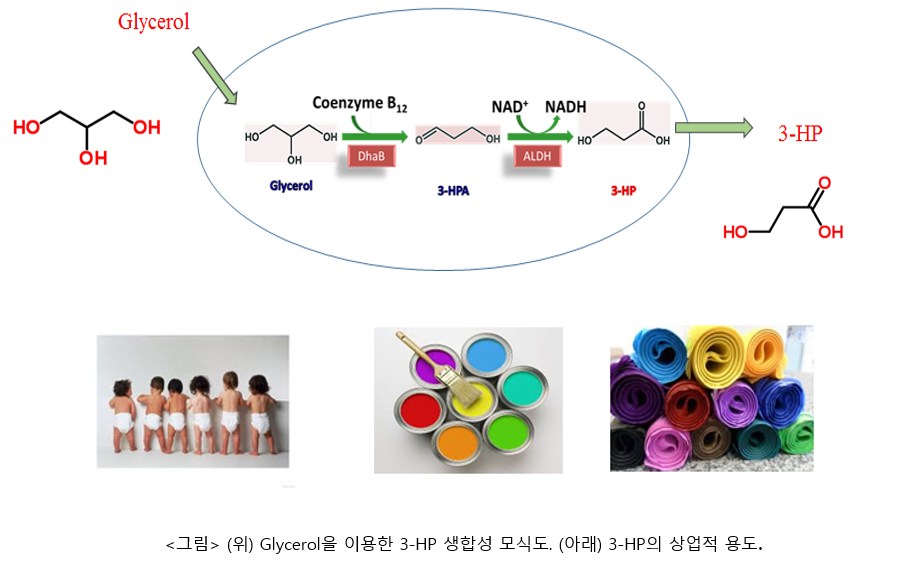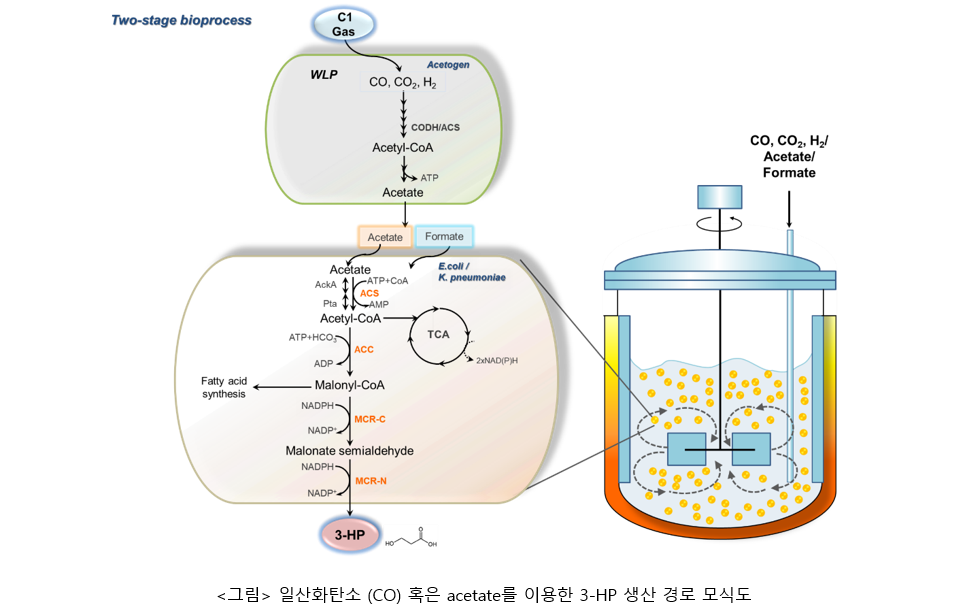3-Hydroxypropionic acid (3-HP)
Production of 3-Hydroxypropionic acid (3-HP)
- 3-HP is a C3 chemical having two functional groups, -OH and –COOH.
- 3-HP is a platform compound which can be converted to many other useful chemicals including acrylic acid, thus has a wide application in the production of pigments, paints, pigments, fibers, etc. Global market is estimated >10 billion USD.
- Biological 3-HP production is preferred to chemical alternative because the production of diapers for babies and elderly people, one major application, is better to be based on bio-based materials and processes. Biological 3-HP production is under serious development by several global chemical and biotech companies such as BASF, Dow, Cargill, etc. Escherichia coli, Klebsiella pneumoniae, Pseudomonas and yeast are developed as microbial cell factories, but no commercial production has not been yet achieved.
- One major technical problem in commercialization of the biological process is serious instability of pathway enzymes and high cost of vitamin B12, an essential cofactor for one pathway enzyme glycerol dehydratase. Another major challenge is separation of purification of 3-HP from aqueous solution. We have solved these problems by discovering a novel 3-HP inducible gene expression system and developing proprietary strains which can naturally synthesize vitamin B12.
- In addition, with collaboration with Professors Gyoo Yeol Jung (POSTECH), Kyung Jin Kim (Kyungpook National Univ) and Tae Hyun Yoo (Ajou Univ), we could greatly improve the efficiency of B12 production in our strains and the activity and stability of pathway enzymes.
- We have transferred our technologies to Noroo Holdings Co., Ltd, Korea several years ago and, now, are working for commercialization with Noroo. Noroo mainly focuses on scale-up, purification and economic analysis of the proprietary process

- During out 10+ year researches for the commercial production of 3-HP, use of several renewable raw materials has been studied:
- Glycerol: Can be produced from vegetable oils such as palm oil and corn oil. Crude glycerol is cheap because it is abundantly produced as a by-product from biodiesel production and contains many impurities. Microalgae growing on CO2 and sunlight can also be the source of glycerol.
- Glucose: Produced by the hydrolysis of starch such as rice and corn. It is most common carbon source for microbial fermentation. Glucose can also be produced cellulosic biomass such as wood and/or grasses.
- Carbon monoxide, carbon dioxide, hydrogen, acetate, etc: Carbon monoxide (CO) and carbon dioxide (CO2), which are one carbon compounds, are emitted in large quantities in coal-burning plants, such as steel-making furnaces and carbon-combustion power plants, and petrochemical processes. They are the main cause of global warming and environmental pollution. They can be used as carbon source for 3-HP synthesis, directly or via acetate.


3-Hydroxypropionic acid (3-HP) 생산
- 3-HP는 젖산의 이성질체로 중요한 플랫폼 화합물임.
- 3-HP는 다양한 용도를 갖는 플랫폼 화합물로 다양한 범용 제품(귀저기, 도료, 안료, 섬유 등)의 생산에 사용될 수 있음 (세계 시장 규모 11조원)
- 글리세롤이나 포도당을 원료로 생물학적으로 생산하는 공정이 활발히 연구되고 있음. 대장균이나 Klebsiella pneumoniae, 효모 등이 연구되었으나 아직 상업적 수준에 이르지 못하고 있음.
- 본 연구실에서는 10년 이상 3-HP 생산을 위한 균주와 공정을 개발하여 왔음. 개발된 기술은 수요기업인 ㈜ 노루홀딩스에 이전되었고 현재 상업생산을 목표로 발효공정 최적화, scale-up, 경제성 분석 등이 진행되고 있음.
- 현재 다음과 같은 원료물질에 대하여 연구가 진행 중임
- 글리세롤: 미세조류나 팜유나 옥수수 기름과 같은 식물성 유지로부터 생산이 가능하며 특히 바이오디젤 생산 후 부산물로 대량 발생하는 저렴한 원료 물질임.
- 포도당: 쌀, 옥수수 등의 녹말의 가수분해를 통해 생산되며 또한 목재나 초본계 셀룰로오스로부터 생산할 수도 있는 탄소원으로 미생물 발효에 가장 널리 사용되고 있음
- 일산화탄소, 이산화탄소, 수소, 아세테이트 등: 탄소수 1개를 갖는 가스화합물인 일산화탄소 (CO), 이산화탄소 (CO2) 등은 석유화학공정이나 자동차배기가스 등으로 대량 배출되며 지구온난화나 환경오염의 주범임. 이들은 직접 혹은 아세테이트를 거쳐 3-HP 생산에 이용될 수 있음.
